Author: Ignas | DeFi Research Translation: Shan Ouba, Golden Finance
To be honest, I have been bullish on the market since mid-2023, but my confidence is starting to waver. This is a good thing, indicating that the market is recovering.
I have also received more and more private messages from crypto OGs, who expressed their concerns about the market, and ETH's performance is the most worrying because it has performed poorly recently. To me, this is a funny sign of a market reversal.
Looking back to March, the consensus at the time was a typical four-year cycle. It felt like everything was going too smoothly. As it turned out, it was indeed going too smoothly!
But how bad is the current situation? I want to jump out of the bubble of X and look at the data myself. So I compiled some data points to understand the real situation we are in and prepare for the next trend.
US ISM Manufacturing Index
This is a bit of an odd starting point, but let me explain.
A year ago, I shared Delphi Digital’s catalysts for the future bull market in a post. Looking back at previous predictions often teaches us important lessons.
In their analysis, Delphi details the “heavyweight” and “lightweight” narratives that will dominate this cycle.
The heavyweight narratives include the Fed’s liquidity cycle, wars, and new government policies.
Delphi accurately predicted that Grayscale’s victory would drive the launch of a BTC ETF, but they (and others) didn’t expect an ETH ETF to follow.
They also successfully predicted the surge of SOL, the rise of AI tokens and the dominance of meme coins, which is admirable.
But there is one thing they seem to have predicted more accurately than others. Please see the picture below. They wrote: "The US ISM is one of the best indicators for predicting asset price trends, and it looks like it is approaching the bottom of a two-year downtrend. The stock market has begun to factor this into the price..." "Surprisingly, the ISM closely tracks the trajectory of previous cycles, including the timing of peaks and troughs. Every 3.5 years, the cycle repeats like clockwork." They also correctly predicted the impact of the ISM on BTC prices. But the problem is that the US ISM manufacturing index reversed its bullish trend in 2024 and began to decline.
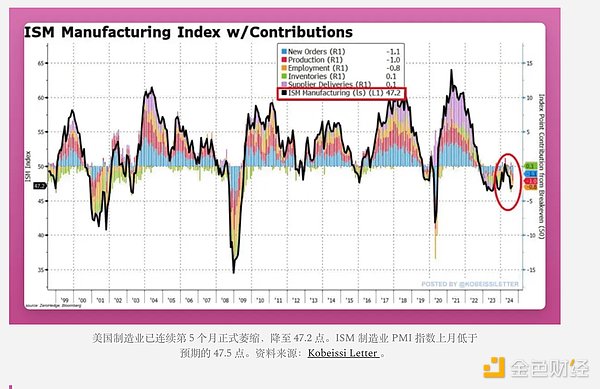
The US ISM index affects the crypto market by influencing economic sentiment, risk appetite, and the strength of the US dollar. A weak index leads to lower risk appetite and selling, while a strong index boosts confidence.
It also affects inflation and monetary policy expectations, and rising interest rates or a stronger US dollar usually have a negative impact on cryptocurrencies.
If the US ISM is one of the best indicators for predicting asset prices, we need to pay attention to its trend and look for signs of market reversals.
Cryptocurrency ETFs
Our newly launched ETF is experiencing a downturn.
In the past 9 days, 8 days, the BTC ETF has seen net outflows totaling $1 billion. This is the longest streak of negative outflows since the ETF was launched.
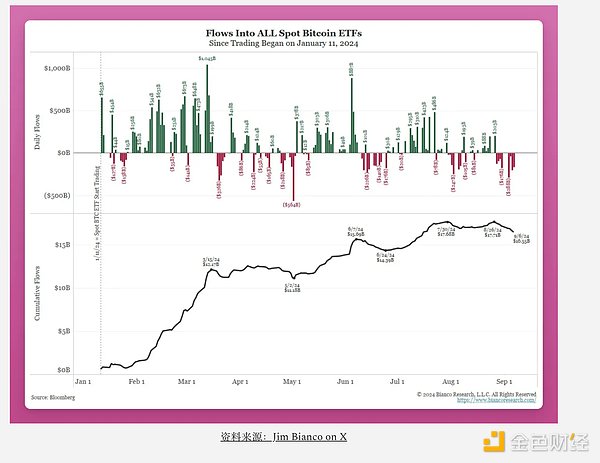
Unfortunately, the situation is getting worse.
According to Jim Bianco, last Friday’s spot BTC close at $52,900 left ETF holders with a record unrealized loss of $2.2 billion, equivalent to a 16% loss. While things have improved slightly at the time of writing, overall sentiment remains depressed.
Bianco also noted that ETFs are not being bought by institutions or older wealthy groups (“boomers”), but by small “tourist” retail investors with an average transaction size of around $12,000. This shift in investor structure raises concerns about the sustainability and long-term growth of these funds.
Crypto quantitative analysis shows that most of the inflows into spot BTC ETFs come from on-chain holders transferring assets back to traditional financial accounts. In other words, there is almost no “new” money flowing into the crypto market, which casts doubt on whether ETFs can actually attract new capital.
The institutions involved are mainly hedge funds that focus on basis trading - that is, profiting from the difference in funding rates - rather than directly betting on the price direction of Bitcoin. The minimal interest from wealth advisors further indicates the limited participation of traditional financial giants in crypto ETFs.
Despite the initial market enthusiasm, it is clear that older wealthy investors ("boomers") are not participating in crypto ETFs. The expected inflows of large amounts of elderly funds have not appeared, further hitting the potential gains of these funds in the short term.
If you think the situation of BTC ETF is bad enough, the fund flow situation of ETH ETF is even more serious.
Ethereum ETFs have performed even more dismally, not only failing to attract a large amount of new capital, but also experiencing sustained outflows. The lack of institutional interest and the retail-dominated landscape highlight the challenges currently facing crypto ETFs, and it is clear that these new investment vehicles are far from being the "panacea" that the market hopes for.
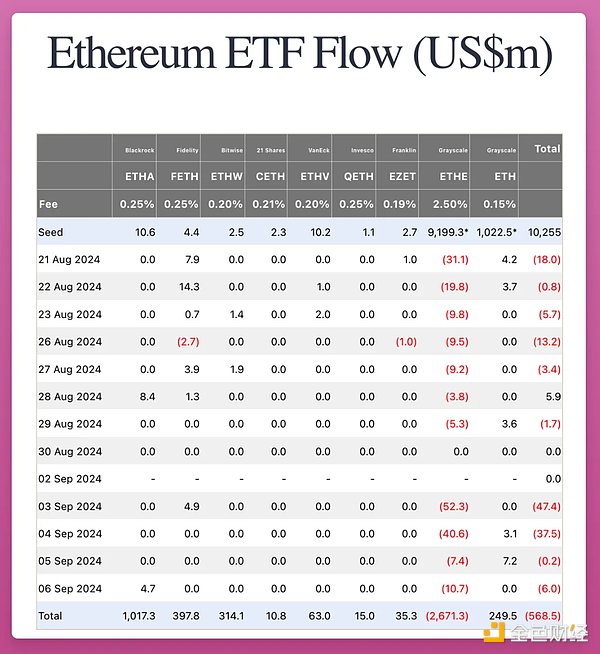
Notice all the zeros?
Even retail investors have little interest in ETH ETFs. Even BlackRock's ETHA has only had inflows on 2 of the past 13 days. And the cumulative fund flows for all ETF issuers are still negative.
Another heavy blow is the continued selling of ETH whales since July.
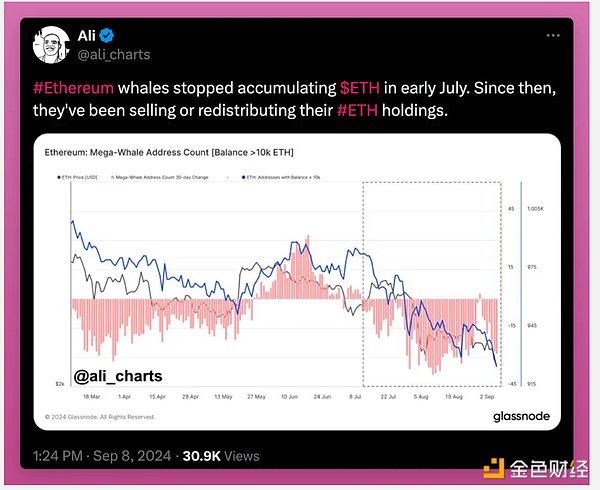
The only good news is that Grayscale has not sold ETH on a large scale. Grayscale currently still holds $5 billion worth of ETH, but the daily fund flow is less than $10 million, and the demand for ETFs cannot absorb these sales.
It's hard to be bearish looking at all the data, but I share my reasons for being bullish on ETH below. Since that article was published, there has been more and more discussion about the ETH roadmap and the value enhancement of L2 to L1. I am bullish that the community can finally focus on the value accumulation of L1.
What are VCs doing?
One of the most confusing puzzles of this cycle is the low fundraising amount. I keep updating the chart below, and despite the BTC rebound, fundraising activity is still lagging.
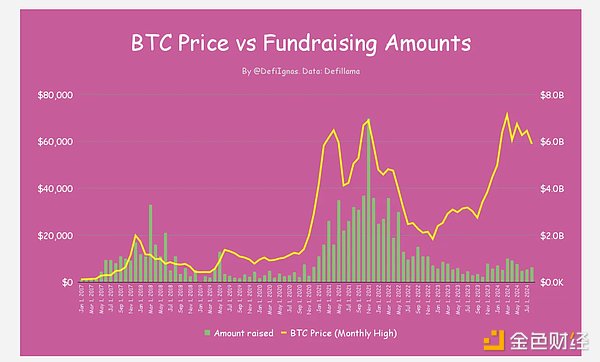
Either VCs know something we don't and are not optimistic about the field; or they are like retail investors, panicking and chasing the highs. Interviews with several VCs show that crypto VCs are like retail investors, but with more funds.
Although the total amount of funds raised is much lower than in 2021, the valuation of early companies has almost doubled, from $19 million in Q1 to $37 million in Q2, close to historical highs.
According to the Galaxy 2024 Q2 Venture Report, despite limited available funds, competition and panic have driven valuations up, especially for investments in early-stage startups.
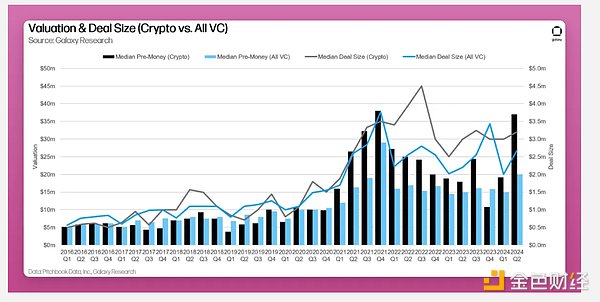
Raising competition intensifies
As cryptocurrency prices rebound, venture capital is scrambling to invest in a few top protocols. For example, Paradigm failed to enter Eigenlayer's investment, so it turned to fund competitor Symbiotic.
Interestingly, despite low retail interest, Web3/NFT/DAO/Metaverse/Gaming projects led in funding, raising $758 million in Q2, accounting for 24% of total VC funding.
The two largest deals were Farcaster ($150 million) and Zentry ($140 million). Infrastructure, Layer 1, and Trading categories followed closely behind. Notably, the combination of crypto and AI still attracts a small amount of funding.
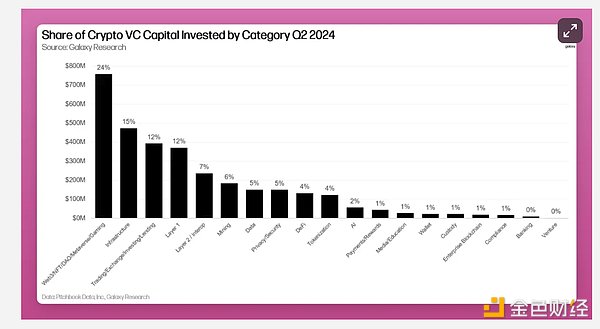
I personally feel that the demand for games and the metaverse is low. At my DeFi creator agency Pink Brains, we used to hire someone to be responsible for GameFi/Metaverse research and community building. However, due to the lack of interest in the gaming field, we had to put this plan on hold.
Interestingly, Bitcoin L2 financing reached $94.6 million, a month-on-month increase of 174%, showing the growing interest of VCs in the BTCFi ecosystem.
Galaxy's 2024 Q2 Venture Capital Report pointed out that investors are looking forward to the emergence of more composable block spaces in the Bitcoin ecosystem, attracting models such as DeFi and NFT to return to the Bitcoin ecosystem.
The report also pointed out that early-stage transactions dominated in Q1, accounting for nearly 80% of investment capital, of which seed round transactions accounted for 13%. This shows the market's positive outlook on crypto innovation.
Despite the challenges faced by mature companies, emerging innovative ideas are still attracting the attention of venture capital.
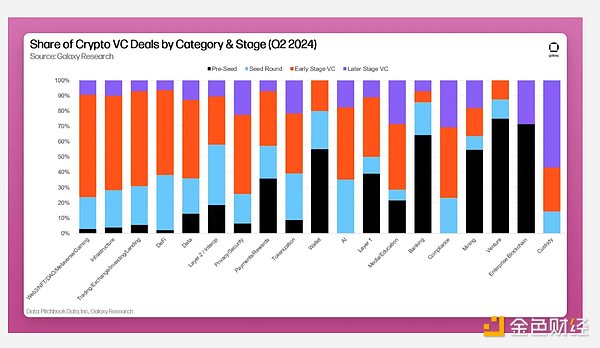
Personally, I can feel the decrease in fundraising activities, because there are few new private messages inviting me to join KOL rounds.
Anyway, I will not invest in KOL rounds, because I feel no special advantage in the private market. I prefer to invest in more liquid investments and keep the content independent.
The current situation of L2: the rise of Base
The good news is that the activity of L2 is exploding. The number of active wallets and weekly trading volume continue to increase, and DEX trading volume has risen for a year in a row.
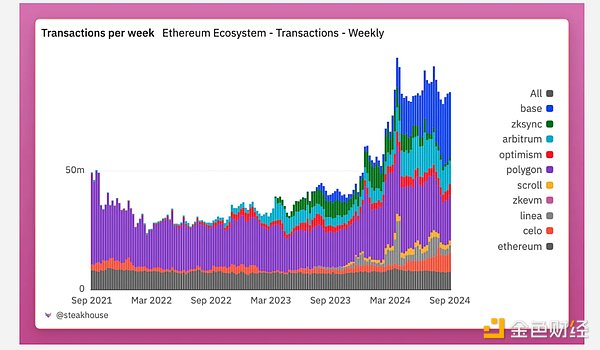
However, Base's growth far exceeds that of other L2s. Please see the blue line representing weekly active wallets.
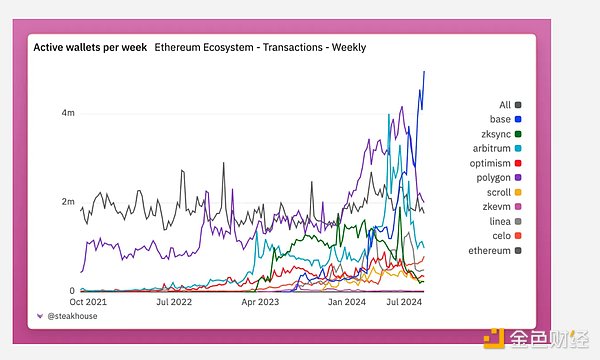
Base continues to attract new users while other L2s are losing users. This growing dominance is particularly evident in the number of DEX traders, with Base accounting for an astonishing 87% market share!
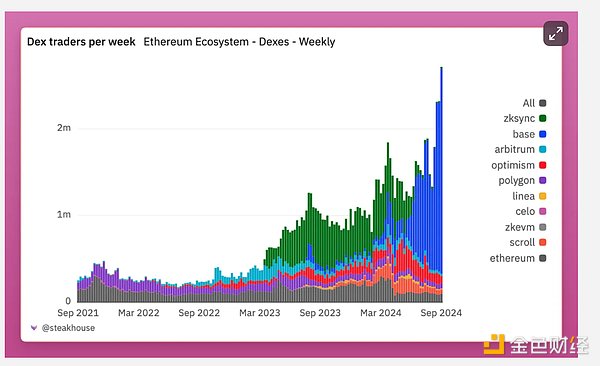
So, what happened here?
Base debuted its Smart Wallet during the Onchain Summer event. While creating a wallet with Passkeys is cool, I mainly minted multiple NFTs through the app just to try it out.
However, the real highlight of Base this summer was the speculation on memecoins, which drove trading volume and wallet counts to all-time highs. You can see that Base and Solana accounted for most of the new token issuance on DEXs.
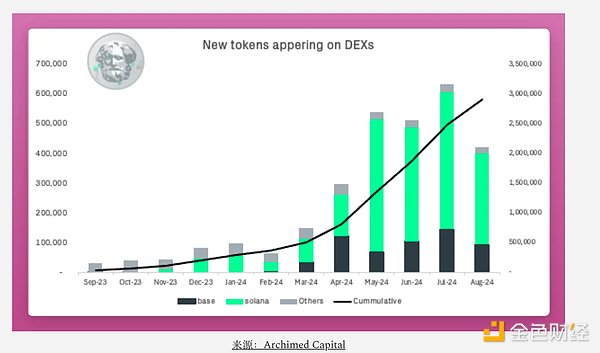
Surprisingly, despite the drop in memecoin prices and the end of summer, trading volume has not decreased.
SocialFi - Don't like Racer and Friend Tech, but...
SocialFi is another area that has seen significant user growth.
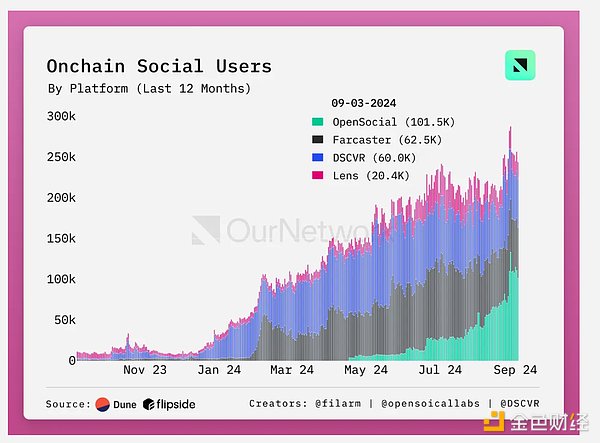
Farcaster and Lens dominate X (formerly Twitter), but the OpenSocial protocol in the Asia-Pacific region recently broke through 100,000 daily active users, surpassing Farcaster's 65,000 and Lens' 25,000 combined. However, few people on X know about the specific functions of OpenSocial. DSCVR, powered by Solana, has also quietly reached 60,000 daily active users, but has hardly attracted any attention.
Despite losing money on Friend.tech, I am still bullish on SocialFi. SocialFi is one of the few crypto areas that has transcended speculation. Vitalik Buterin once said in an AMA that decentralized social media is his favorite area.
According to Yano, OpenSocial was overlooked because crypto news media and X are mainly dominated by the West, while OpenSocial is based in Asia, with users mainly from Indonesia, Vietnam and India, with the United States ranking fourth.
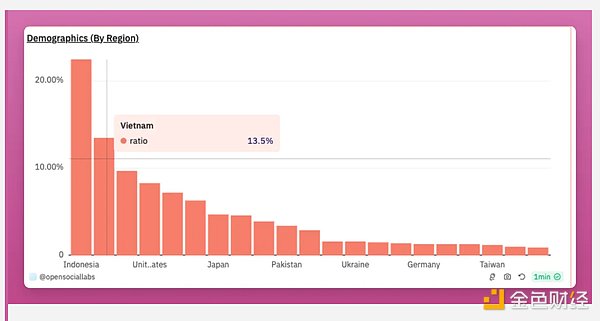
OpenSocial has built a decentralized social platform that allows creators and communities to fully own their own social networks and data. Users can build and control their own social applications, communities, and assets without relying on mainstream platforms such as Facebook or Twitter. This gives users more control, ownership, and the ability to earn revenue through content and interaction, making social media more open and fair.
Similar to Lens or Farcaster, OpenSocial is a basic platform on which multiple applications and interfaces run. Social Monster (SoMon) is the app with the most daily active users. While you can try, all experiences are full of bugs…
The key is to recognize that while the crypto narrative is dominated by Western audiences, the reality is that there are many real users around the world who may use crypto differently than the OGs on X portray.
Understanding the current market situation through data charts
Here are some data points to help us understand the current market situation:
IPOR Stablecoin Index: Data shows that on-chain leverage has dissipated and lending rates are back to pre-2023 rally levels. During the airdrop farming period, lending rates soared, but due to poor airdrop results, farmers closed their circular positions.
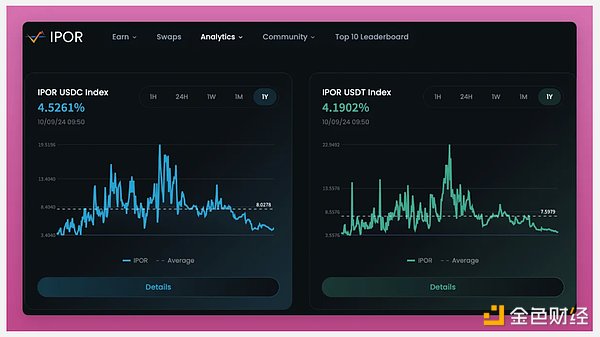
BTC Open Interest: BTC open interest shows that leverage has also reset. Funding rates were higher in March but turned negative in April and July/August, meaning shorts paid longs, indicating that traders expected a market decline. However, open interest (OI) is currently positive again.
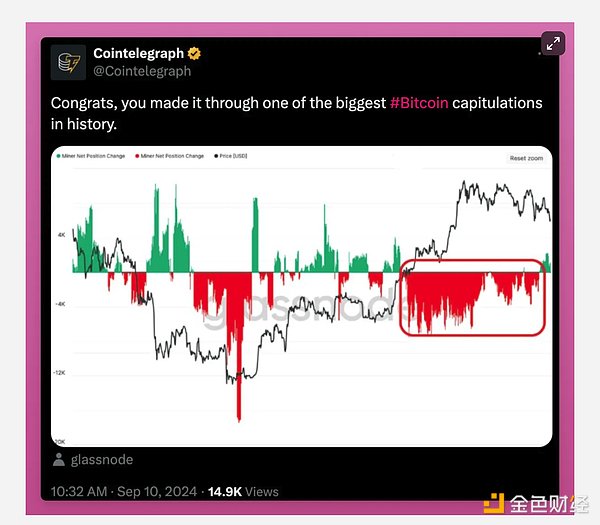
Miners Selling: Another bullish indicator is the selling behavior of miners. Miners seem to have stopped selling and have started accumulating BTC again.
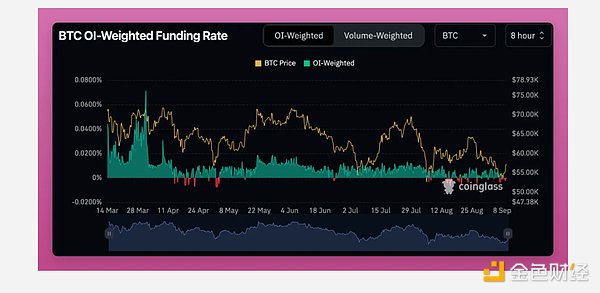
Stablecoin Supply: The continued growth in stablecoin supply may be a more optimistic chart.
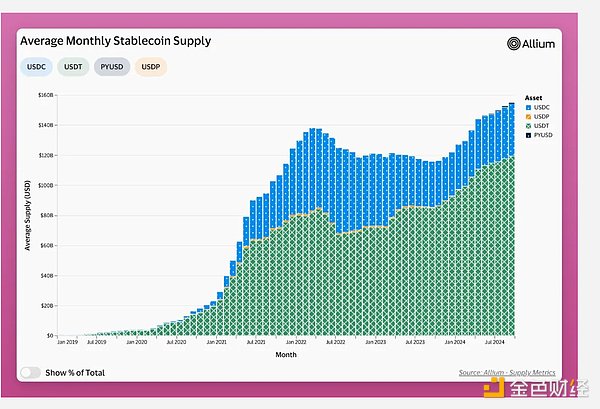
The total supply is rising, but the difference is that USDT supply has increased while USDC has shrunk from $55 billion to $34 billion. Why?
First, the collapse of Silicon Valley Bank caused USDC to decouple, marking the apex of USDC supply. Another possible explanation is that the US policy proposed by Nic Carter pushed investors into less regulated offshore stablecoins, so USDC growth stagnated while USDT continued to expand.
If this is true, pro-crypto US regulation could be a bullish catalyst for USDC gains… oh wait…
Regulatory situation: In 2024, the US SEC collected $4.7 billion in fines from crypto companies, a 30x increase from 2023.

This money, which should have been invested in the crypto sector, ended up in the hands of government bureaucrats rather than the actual victims of the crypto sector.
The biggest chunk of that was the $4.47 billion settlement with Terra. The good news is that the SEC is moving toward “fewer but bigger fines,” with a focus on high-impact enforcement actions that set industry precedents, according to a Social Capital report.
Summary: Up or Down?
Yes, things are looking bad right now.
With the ISM falling, no demand for ETH ETFs, and VCs hesitant, it’s not a great environment right now. But that’s how markets repair. When everyone is panicking, it usually means we’re closer to the bottom than we thought.
Sure, there are bearish data points, but there are also plenty of reasons to be bullish. L2 is strong (especially Base), social platforms like Farcaster and OpenSocial are growing, and leverage is being cleared. While the heat has cooled, key areas remain active.
Regulation is a mess and the SEC is squeezing the industry. We need to see a shift in US regulatory attitudes, or a change in leadership, to stop the market from bleeding further. Crypto-friendly regulation may be a bullish trigger. Until then, the pressure remains. But remember, even if the Democrats win the election, they may need to turn the printing press back on to deliver on all their promises. And in this money-printing environment, Bitcoin is the best asset.
At the end of the day, markets don't move in a straight line. We are in that chaotic phase where emotions are shaky, and that's normal. Stay focused, pay attention to the data, and don't get caught up in the noise.
Bullish trends are often not obvious until they are right in front of you. All in all, I'm still bullish on the market.
Of course, I could be wrong.
 JinseFinance
JinseFinance























